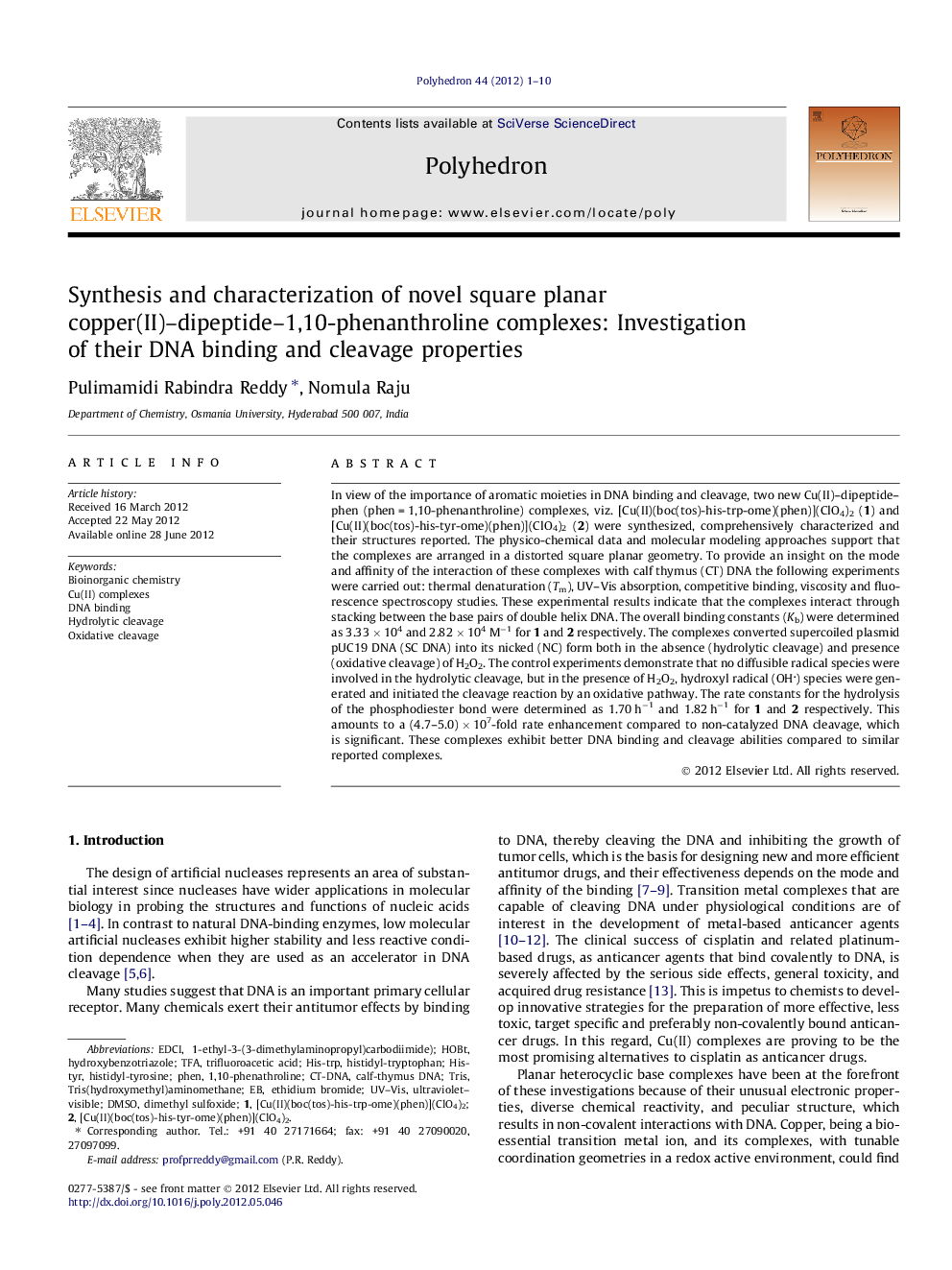| Article ID | Journal | Published Year | Pages | File Type |
|---|---|---|---|---|
| 1334718 | Polyhedron | 2012 | 10 Pages |
In view of the importance of aromatic moieties in DNA binding and cleavage, two new Cu(II)–dipeptide–phen (phen = 1,10-phenanthroline) complexes, viz. [Cu(II)(boc(tos)-his-trp-ome)(phen)](ClO4)2 (1) and [Cu(II)(boc(tos)-his-tyr-ome)(phen)](ClO4)2 (2) were synthesized, comprehensively characterized and their structures reported. The physico-chemical data and molecular modeling approaches support that the complexes are arranged in a distorted square planar geometry. To provide an insight on the mode and affinity of the interaction of these complexes with calf thymus (CT) DNA the following experiments were carried out: thermal denaturation (Tm), UV–Vis absorption, competitive binding, viscosity and fluorescence spectroscopy studies. These experimental results indicate that the complexes interact through stacking between the base pairs of double helix DNA. The overall binding constants (Kb) were determined as 3.33 × 104 and 2.82 × 104 M−1 for 1 and 2 respectively. The complexes converted supercoiled plasmid pUC19 DNA (SC DNA) into its nicked (NC) form both in the absence (hydrolytic cleavage) and presence (oxidative cleavage) of H2O2. The control experiments demonstrate that no diffusible radical species were involved in the hydrolytic cleavage, but in the presence of H2O2, hydroxyl radical (OH) species were generated and initiated the cleavage reaction by an oxidative pathway. The rate constants for the hydrolysis of the phosphodiester bond were determined as 1.70 h−1 and 1.82 h−1 for 1 and 2 respectively. This amounts to a (4.7–5.0) × 107-fold rate enhancement compared to non-catalyzed DNA cleavage, which is significant. These complexes exhibit better DNA binding and cleavage abilities compared to similar reported complexes.
Graphical abstractHistidine based dipeptides Cu(II) complexes, [Cu(II)(boc(tos)-his-trp-ome)(phen)](ClO4)2 (1) and [Cu(II)(boc(tos)-his-tyr-ome)(phen)](ClO4)2 (2), were synthesized, characterized and structurally established. The DNA binding and cleavage properties (oxidative and hydrolytic) of these complexes were studied. The complexes bind to CT-DNA in an intercalative mode. The present complexes cleave DNA more efficiently compared to aliphatic dipeptide complexes due to the presence of aromatic moieties, such as indole and hydroxyl-phenyl rings.Figure optionsDownload full-size imageDownload as PowerPoint slideHighlights► Histidine based dipeptide Cu(II) complexes were synthesized, characterized and geometries established. ► They bind to DNA in an intercalative mode. ► They are efficient cleavers of DNA both oxidatively and hydrolytically. ► The study established the importance of aromatic moieties in DNA binding and cleavage. ► The hydrolytic rate constants are in the order (4.7–5.0) × 107.
